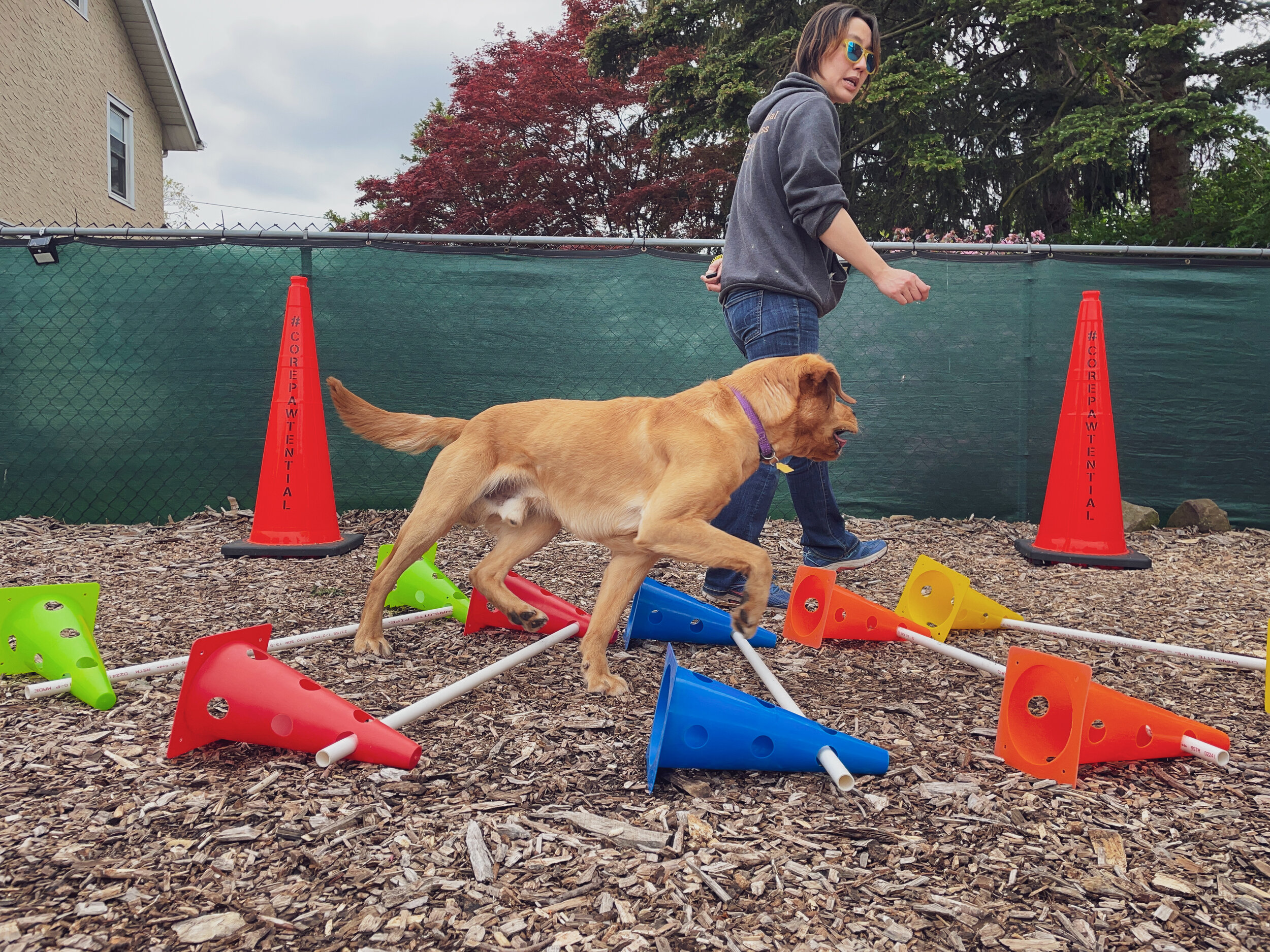
Cavaletti Troubleshooting
Module 1
Beginner
My dog keeps knocking over/stepping on the poles
It is possible that distance between the cavaletti poles may be off. Check to make sure the distance between two poles is at your dog's withers height or twice your dog's elbow height. If your dog is still knocking over/stepping on the poles, try the following:
Set up 2 poles at a distance wider than your dog's withers height on the floor (e.g., if your dog measures 24" at the withers, set up the poles so they are 26" apart). Walk your dog over the poles slowly, it may be helpful to put a few cookies before the first pole and in between each pole to help slow them down. Do this a few times to help him understand the idea of being mindful of his feet. Depending on the individual dog, this may be achieved in one short session, or a few short sessions over a few days.
Once your dog is able to walk across the poles without knocking over/stepping on them, set up the poles so that the distance between the poles are your dog's withers height. Walk him over the poles a few times to remind him of the exercise. Slowly increase speed so that he is able to maintain a trotting gait.
My dog keeps jumping over the poles
Here are a few things to try:
- Set up fewer poles (2-3 poles) at your dog's withers height on the floor or at the lowest height possible.
- Set up 2 poles at a distance wider than your dog's withers height (e.g., if your dog measures 24" at the withers, set up the poles so they are 26" apart) to see if he is able to trot over them instead of jumping over them.
- Try using an "anchor" at each end of the setup to help calm your dog. Mark as your dog reaches the anchor, and reward from your hand instead of throwing a cookie for them. Since the dog will be driving to the "anchor," they will still be focusing forward.
- You can also put a few cookies before the first pole for your dog to eat. Slow down your movement and lowering your voice can often help calm your dog down as well.
My dog keeps looking up at me
Mark and throw the cookie before they finishes the last pole to keep them focusing forward. If you are working on fewer poles (e.g., 3 poles), this may mean that you are marking as they trot over the first pole! You can also try the "anchor" method.
Use your body language to help support your dog - i.e., turn your body towards the intended direction instead of facing your dog.
My cookies keep missing the bowl
This is a very common to have, in fact, I am not a great cookie thrower either! I would recommend using a bigger bowl, and/or using bigger cookies (e.g., sliced up hot dogs/cheese are great options). Keep in mind that the bowl is there as a visual cue for the dog, your dog still gets the reward even when the cookie happens to fall outside of the bowl.
Do you use a different marker word for getting onto the "anchor" object and getting cookie from the bowl?
My marker word for both is, "YES." For me, the marker word here lets the dog know that the way he is moving across the cavaletti poles is correct. I do not have separate marker words to distinguish how the cookie is to be delivered - cookie from my hand on "anchor" object vs. cookie thrown into the bowl.
If you have separate marker words to distingush how cookie is being delivered, you can use them as well.
Do I have to measure the distance between poles every time?
Yes and no. In the beginning, I would recommend measuring the distance every time to make sure the distance is correct. This is especially important if you are working multiple dogs. Even dogs of similar size may have slightly different measurements of height at the withers. It is important to adjust the distance of the cavaletti poles accordingly.
Once you are used to setting up the cavaletti poles for your dogs, you can usually eyeball the distance between poles and make slight adjustments accordingly.
How do you keep track of the number of reps in a session?
I count out the number of cookies in my hand/pocket. For example, if I intend to do 10 reps, I would have 12 cookies in my hand. The first cookie is a free cookie at the start of the session. Cookies 2 to 11 are for the 10 reps. The 12th cookie is a free cookie for my dog for a job well done.
Intermediate
My dog does not want to do multiple reps
Make sure your dog is comfortable with at least 10 single reps in a session with your intended number of cavaletti poles. For example, I will not attempt multiple reps with 5 poles unless a dog is able to complete 10 reps of 5 poles in a session, maintaining a trotting gait, focusing forward, and with good form and posture.
When are you ready to do multiple reps, warm up with a few single reps, ask for a multiple rep (2 reps), then ask for a few single reps. My first session attempting a multiple rep may look like this:
- Rep 1: trot over 5 poles, mark + reward
- Rep 2: trot over 5 poles, mark + reward
- Rep 3: trot over 5 poles, mark + reward
- Rep 4: trot over 5 poles, wrap cone, trot over 5 poles, mark reward
- Rep 5: trot over 5 poles, mark + reward
- Rep 6: trot over 5 poles, mark + reward
By mixing multiple reps with single reps, we can keep the dog interested while increasing difficulty.
I do not have enough room to set up more than 5 poles, how can I increase the number of poles?
I totally understand that space is limited. If you do not have room to set up more than 5 poles, I would recommend working on multiple reps as an alternative to increasing the number of poles.
For example, if your dog is comfortable with 1 set of 10 reps of 5 poles, you can try to aim for 1 set of 4 double reps (i.e., trot across the 5 poles twice before mark + reward). In other words, you are increasing the number of poles the dog has to trot through before they are rewarded.
My dog slows down before we finish 1 set of 10 reps
Slowing down is one of the common signs of fatigue. I would recommend aiming for a lower number of reps to build up the stamina (e.g., 1 set of 6-8 reps) for a few sessions before trying to do 1 set of 10 reps.
I would also recommend keeping a record of the number of reps at which your dog starts to slow down. If your dog does not seem to be improving despite reducing the number of reps, it is possible that there is other underlying issues that should be addressed.
How high should I raise the poles off the ground?
Depending on the size of your dog, this adjustment could range from 1/16" to 1/4".
For my medium sized dogs, I usually increase the height at about 1/4" at a time. For example, if the poles are typically 1/2" off the ground, I would increase the height to 3/4" once they are able to meet my intended goals.
If you have toy breeds, raising the poles 1/16" could make a big difference to the tiny dogs.
Advanced
My dog trips over the higher poles.
First, make sure the poles are not raised too high. The higher poles should be no higher than the highest height (and no higher than hock height) that your dog is comfortable with in the intermediate level. For example, if your dog is able to trot comfortably when the poles are 1" off the ground, the highest poles should not be higher than 1".
Next, check that the poles are set at the correct distance for your dog. If you had been working on increasing the distance between poles for your dog, you may have to reduce the distance (e.g., start at withers height or twice the elbow height) between the poles.
If your dog is still tripping over the higher poles, decrease the height difference between the "low" and "high" poles. For example, instead of having poles set at 1" and 1.5" off the gound, try setting them at 1" and 1.25" off the ground. If your dog is still tripping over the higher poles, lower the poles to 3/4" and 1".

